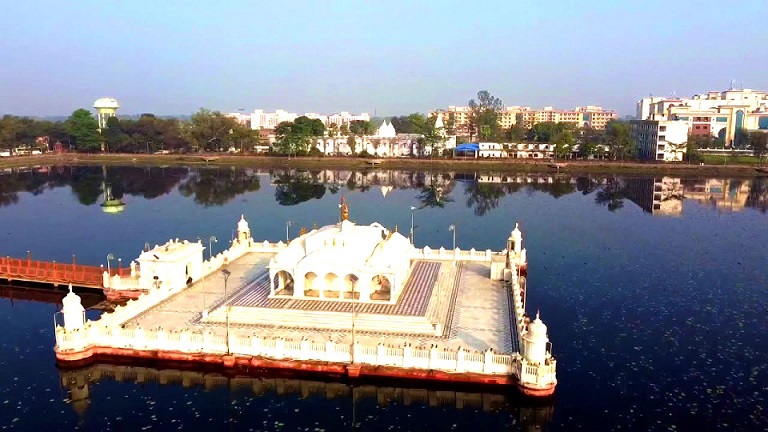Depawali and Jain Faith
 |
By: Anil Jain : Ahimsa Foundation
Bhagwan Mahavira Nirvana Divas or Mahavir’s Nirvan Kalyanak Divas is Deepawali day in Jain faith. On this day Lord Mahavira, the 24th Jain Tirthankara had attained the bliss of Nirvana on the dawn of Amavasya of the Ashwin month (Hindu calendar), 527 B.C. at Pavapuri. It was a dark night so the sixteen Gana kings , nine Malla and nine Lichchhavi of Kasi and Kosal decided thelight of their master’s knowledge should be kept alive symbolically by lighting the lamps.
Since that time, Jains celebrate the festival of Deepawali to commemorate the attainment of Moksha by Lord Mahavira. The Jain community illuminates their houses and temples with clay lamps to celebrate this event. This act also guides mortals to light up their inner vision by implementing the path preached by Lord Mahavira. Some observe fast for three days in remembrance of the sacrifice of Lord Mahavira. They also recite “Shri Mahavir Swami Sarvajnaya Namah” on every bead of the mala or rosary (108 beads), followed by nineteen malas of the mantra, Shri Mahavir Swami Paragataya Namah on each bead.
Diwali festival was first time mentioned in Harivamsha Purana (Holy Book of Jains) written by Acharya Jinasena, and composed in the Shaka Samvat era in the year 705. Acharya Jinasena mentions that Bhagavan Mahavir, attained nirvana at Pavapuri in the month of Kartika, Krashnapaksha, during swati nakshatra, at the time of dawn.
In Harivamsha-Purana 19th & 20th Shloka says that: "the gods illuminated Pavanagari by lamps to mark the occasion. Since that time, the people celebrate the festival to worship the Lord Mahavira on the occasion of his nirvana.
Bhagwan Mahavir knowing his emancipation was very near, reached Pavapuri alias Apapa town. The Heavenly Gods created Samosaran(beautiful dome). Bhagwan Mahavir sat on golden throne inside Samosaran. It was Kali Chaudash. His principal eleven disciples were present including Gautamswami. Heavenly gods and goddesses too were present with a huge crowd of people comprising of all sections. One of them was KingPunyapal. He had received eight dreams the night before. Punyapal told Mahavir that he had become scared after having these dreams. He narrated them before Mahavir and requested Mahavir to forecast its results. The mention of eight dreams is of important and the names are: 1. Elephant 2. Monkey 3. Kshirvruksha 4. Crow 5. Lion 6. Lotus 7. Beej (seeds) 8. Kumbha (pot). These dreams seem to be beautiful but its significance was horrible relating to entire Jain four fold organizations and universe.
Mahavir gave discourses for 16 Praharas continuously i.e. two days and two nights without any break. In these 16 Praharas he spoke on 55 categories of Punya (merits) and 55 categories of Paap (demerits). These are well-known as Uttaradhyayan Sutra in Jainism. Mahavir also forecasted the horrible future of fifth and sixth Aras of the present Avasarpini. As soon as the time for emancipation reached nearer, Mahavir asked Gautam to go to a farmer named Devsharma and enlighten his soul with knowledge. This was the day of Amavasya in the month called Ashwin.
At midnight, Mahavir attained emancipation and relinquished this universe forever. He sat on the abode of Salvation. He never returned from there. His emancipation caused the extinguishing of Bhav Deepak and turned the atmosphere into darkness and hence those who were present at that time lighted Dravya Deepak. Deepawali festival since then commenced for Jains. It is a celebration of “Nirvana Kalyanak”and not enjoyment of worldly pleasures.
Later, Gautamswami returned after meeting Devsharma. He learned about the emancipation of Mahavir and began crying. He then went into deep thinking and converted these thoughts into meditation and concentration on non-attachments. At the dawn of the first day of the new month i.e. Kartik he achieved luminous and brilliant kevalgyan (Omniscience). Heavenly Gods celebrated his Kevalgyan with all gaiety and pleasures.
The Deepawali echoes the melodious rhythm of liberation but unfortunately due to ignorance, people fastens themselves with new clutches instead of achieving redemption. Many at this time, celebrate this occasion with the crackers just out of sheer ignorance. This is an evil as it results in the loss of material and natural resources.
Rituals :As part of cebrations,on Dhan Terash, business man carry out Pujaof their books of accounts. They prefer to close down their shutters after this Puja for eight days. On Kali Chaudash, most of the Jains start observing fast for two consecutive days. They sit in Jaap means counting rosary at night. Some enter in to Paushadh for two days. On Amavasya Day, people visit the temple to worship and meet each other. They distribute clothes, give donations and again at night sit in Jaap. The Jaap mantra is “Mahavir SwamiPargatay Namah”. On New Year’s Day, people greet each other and express best wishes for the forthcoming New Year. As midnight passes those doing Jaap start chanting “Gautamswami Keval Gnyaya Namah”. On the second day of New Year, there is a procession of an idol of Mahavir. This is called Bhai Beej. On the third day of New Year, temples and Jina idols are decorated with flowers. On the fourth day of New Year, people visit temples and pray. On the fifth day of New Year, it is Gyan Panchami or Shrut Panchmi. On this day Jains worship “knowledge” with different materials, sweets and fruits. They also count the rosary to gain pure knowledge.
 |
-----------------------------------------------------
Anil Jain
9810046108
Mail to : Ahimsa Foundation
www.jainsamaj.org
R11112023